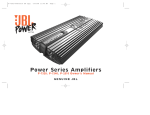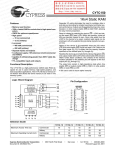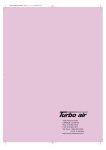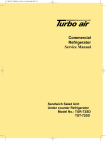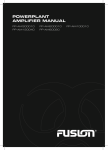Download JBL LC-A752 Car Audio Amplifier
Transcript
LC-Amplifier OM A 3/4/99 10:55 AM m Page 2 p l i f i e r s LC-Amplifier OM 3/4/99 10:55 AM Thank you for purchasing a JBL Loud + Clear amplifier. In order that we may better serve you should you require warranty service on your new amplifier, please retain your original purchase receipt and return the enclosed warranty registration card. Important: Installation of automotive stereo components can require extensive experience in performing a variety of mechanical and electrical procedures. Although these instructions explain, in a general sense, how to install Loud + Clear amplifiers, they may not show the exact installation methods for your particular vehicle. If you feel you lack the tools or necessary experience, ask your authorized JBL car-audio dealer about professional installation options. Page 3 Installation Warnings and Tips • Always wear protective eyewear when using tools. • Turn off all audio systems and other electrical devices before you start. • Disconnect the negative (–) lead from your vehicle’s battery. • Check clearances on both sides of a planned mounting surface before drilling any holes or installing any screws. Remember that the screws can extend behind the surface. • At the installation sites, locate and make a note of all fuel lines, hydraulic brake lines, vacuum lines and electrical wiring. Use extreme caution when cutting or drilling in and around these areas. • Before drilling or cutting holes, use a utility knife to remove unwanted fabric or vinyl to keep material from snagging in a drill bit. Choosing a Location and Mounting the Amplifier Amplifiers need air to stay cool. Suitable locations are under seats (provided the amplifier doesn’t interfere with the seat-adjustment mechanism), in the trunk or in any location that provides enough air for the amp to cool itself. Do not mount the amplifier with the heat-sink fins facing downward; this makes convection cooling of the amplifier impossible. Mount the amplifier so that it is not damaged by the feet of back-seat passengers or shifting cargo in the trunk. Mount the amplifier so that it remains dry – never mount an amplifier outside the car or in the engine compartment. Using the amplifier as a template, mark the location of the mounting holes on the mounting surface, drill pilot holes and attach the amplifier to the mounting surface with screws. Make sure the amplifier is mounted securely. • When routing cables, keep inputsignal cables away from power cables and speaker wires. • When making connections, ensure that they are secure and properly insulated. • If the amplifier’s fuse must be replaced, use only the same type and rating as that of the original. Do not substitute another kind. If you are bridging the amplifier, connect the speaker wires to the terminals marked “bridged,” observing proper polarity. The total impedance of the speaker system connected to the amplifier must be at least four ohms in bridged mode. If you are running the amp in Tri-Mode (stereo and mono simultaneously), connect the satellite speakers to the speaker connector as you would a pair of stereo speakers. Connect the subwoofer to the terminals marked “bridged.” Refer to the chart below to determine the capacitor and inductor values you’ll need to route bass signals to the woofer, and the midrange and high frequencies to the satellite speakers. These passive crossover components will also ensure that the impedance of the speaker system doesn’t drop below two ohms. FREQUENCY INDUCTOR CAPACITOR Crossover 6dB/oct. LP (4 ohm) 6dB/oct. HP (4 ohm) 75Hz 100Hz 125Hz 150Hz 175Hz 200Hz 8.0mH 6.4mH 5.0mH 4.2mH 3.6mH 3.2mH 530µF 400µF 318µF 265µF 227µF 198µF Wiring the Power Connections Refer to Figures 1–4 for connector locations. Use at least 10-gauge wire for power and ground connections. For power, remote and ground connections strip off one end of each jacket to reveal bare wire for insertion into the barrier-strip connectors. Connect a wire from the GND connector on the amplifier to the nearest bare-metal chassis component; scrape away the paint to ensure good conductivity. Next, connect a wire between the BATT terminal on the amplifier and the POS (+) terminal of the vehicle’s battery. Pass the wire through a factory-installed grommet in the firewall, or install a grommet if a factory grommet is not available. You must install, within 18" of the battery connection, a fuse holder and fuse with the same rating as the fuse in the amplifier’s chassis. This will prevent a short circuit from causing damage to the amplifier or the car. Connect a wire between the REM terminal of the amplifier and the “remote out” or power-antenna lead on the vehicle’s radio. Wiring the Speaker-Output Connections Connect the speakers, observing proper polarity, to the speaker-output barrier strip. The total impedance of the speaker system connected to the amplifier when the amplifier is driven in stereo must be at least two ohms. Warning: Playing loud music in an automobile can permanently damage your hearing as well as hinder your ability to hear traffic. We recommend listening at low levels while in your car. JBL accepts no liability for hearing loss, bodily injury or property damage resulting from use or misuse of this product. LC-Amplifier OM 3/4/99 A 10:55 AM m Page 4 p l i f i e r s Wiring the Input-Signal Connections Connect a pair of signal cables with RCA-type ends between the connectors on the amplifier and the RCA-type signal connectors on the source unit. If your radio has only speaker-level outputs, you must purchase a speakerlevel-to-line-level adapter, commonly sold as an accessory. System Setup and Adjustment Refer to figures 1–4 for location of adjustment switches and controls. Electronic Crossover (for LC-A752 and LC-A504) The electronic crossover can be selected as a 12dB/oct high-pass filter (HPF), 12dB/oct low-pass filter (LPF) or it can be defeated (FLAT). The crossover frequency can be set at any frequency between 32Hz and 320Hz. Setting Input Level Initially, turn the input-sensitivity LEVEL control to its maximum (counterclockwise) position. Turn on the source unit and increase the volume control until it is approximately three-quarters of maximumoutput level. Slowly increase the input LEVEL control (clockwise) while listening to the quality of the reproduced sound. When you hear distortion on the music peaks, turn the LEVEL control back slightly. This is the maximum undistorted output level of your system. Turning the LEVEL control up farther WILL NOT INCREASE THE OUTPUT POWER OF YOUR AMP! It will only decrease the amount of volume control rotation before the amp is at full output power. It will also increase the amount of extraneous noise present in your system. Model No. LC-A502 Model No. LC-A304 FRONT PANEL FRONT INPUT LEVEL LINE INPUT FRONT PANEL RIGHT LINE INPUT 4V 250mV POWER INPUT LEVEL RIGHT LEFT REAR LINE INPUT POWER 4V 250mV LEFT FUSE 20 AMP OUTPUT RIGHT RIGHT 4V 250mV LEFT REAR PANEL REAR PANEL LEFT INPUT LEVEL BATT(+) POWER REM REAR OUTPUT LEFT GND (-) FRONT OUTPUT LEFT RIGHT BRIDGED BRIDGED Figure 1 POWER RIGHT BATT(+) GND (-) FUSE 20 AMP BRIDGED Figure 3 Model No. LC-A752 Model No. LC-A504 FRONT PANEL INPUT LEVEL LINE INPUT FRONT PANEL FRONT CROSS OVER LINE INPUT INPUT LEVEL POWER RIGHT REAR POWER CROSS OVER CROSS OVER LINE INPUT INPUT LEVEL RIGHT LPF RIGHT HPF LPF FLAT 4V LEFT 250mV 32Hz 320Hz FREQUENCY 4V LEFT REAR PANEL OUTPUT LEFT RIGHT FUSE 25 AMP 250mV LPF HPF FLAT 32Hz 320Hz FREQUENCY 32Hz 320Hz FREQUENCY HPF FLAT 4V 250mV LEFT REAR PANEL BATT(+) POWER REM FUSE 20 AMP GND (-) BRIDGED Figure 2 REM REAR OUTPUT BRIDGED Figure 4 FRONT OUTPUT RIGHT LEFT LEFT POWER RIGHT BRIDGED BATT(+) REM GND (-) FUSE 20 AMP LC-Amplifier OM 3/4/99 A 10:55 AM m Page 1 p l i f i e r s Troubleshooting Symptom Likely Cause Solution No audio (power indicator is on). Speakers or input-signal cables disconnected; defective speaker or source unit. Check connections, source, speakers. No audio (power indicator is off). No voltage at BATT or REM terminals; bad ground connection. Check voltage at amplifier terminals with VOM. Repair faulty connection. No audio (power indicator is off, voltage at terminal OK). Amplifier protection is engaged due to overheating; shorted or defective speaker or speaker cable. Disconnect speaker leads one at a time to determine which speaker or wire is shorted or defective. Repair the short circuit or replace bad speaker. Distorted audio. Input sensitivity not set properly; amplifier or source unit defective. Check LEVEL setting; check source unit. Music lacks "punch". Speakers are not connected properly. Check speaker connections for proper polarity. LC-A502 LC-A752 LC-A304 LC-A504 Power Output, 4 Ohms 50W x 2 75W x 2 30W x 4 50W x 4 Power Output, 2 Ohms 65 W x 2 90W x 2 37.5W x 4 62.5W x 4 Specifications Power Output, 4 Ohms Bridged Frequency Response Input Sensitivity 130W x 1 180W x 1 75W x 2 125W x 2 20Hz – 40kHz 20Hz – 40kHz 20Hz – 40kHz 20Hz – 40kHz 250mV – 4V 250mV – 4V 250mV – 4V 250mV – 4V .10% .10% .10% .10% >90dB >90dB >90dB >90dB THD + Noise Signal-to-Noise Ratio Maximum Current Draw Dimensions (H x W x D) 20A 26A 23A 42A 2-5/16" x 8-5/16" x 7-9/16" 2-5/16" x 8-5/16" x 12-1/2" 2-5/16" x 8-5/16" x 11-5/8" 2-5/16" x 8-5/16" x 14-1/16" (58mm x 217mm x 191mm) (58mm x 217mm x 317mm) (58mm x 217mm x 297mm) (58mm x 217mm x 357mm) JBL Consumer Products 250 Crossways Park Drive, Woodbury, NY 11797 8500 Balboa Boulevard, Northridge, CA 91329 1-800-336-4JBL (4525) (USA only) www.jbl.com © 1999 JBL, Incorporated JBL is a registered trademark of JBL, Incorporated. Part No. LC-AMPOM 3/99 R E CYCL ABL E






